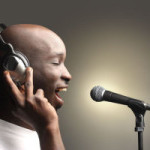Sing Like You Speak® Chapter 1

Enjoy Chapter 1 of Sing Like You Speak® with Power, Freedom and Joy!
“All music is folk music. I ain’t never heard a horse sing a song.” ~ Louis Armstrong
Sing Like You Speak® is a new paradigm of vocal technique that uses proper structures of diaphragmatic belly breathing, body alignment and free release of breath and sound. Layered on top of this solid assembly are the skills vital to contemporary vocalists. Sing Like You Speak® training makes your singing as simple and natural as talking to your best friend.
Sing Like You Speak® Paradigm
A paradigm is defined as a model that serves as a pattern to form the basis of a methodology. The Sing Like You Speak® methodology patterns, briefly illustrated in this chapter, are designed to restore the natural function of your vocal instrument. The exercises are designed to practice and habituate the necessary coordination of a complex vocal system that ensures simple, natural vocal production – based in the actual physiology of the human instrument. The exercise chapters offer more in-depth explanations of the coordination that supports healthy vocal production.
When I look back at developing Sing Like You Speak® I marvel at where it all came from. It came from my need to unlock the voice I knew was trapped inside of me. It came from the need to teach my students how to find the vocal freedom and power that we all crave with our singing.
I had studied voice for about 30 years, having started training as a teenager spending over $100,000 on lessons. It began around 2005 when I realized that over many years I had spent upwards of $100,000 on voice lessons. I learned a lot about the voice and how to teach – and how not to teach – in that time. There were still deep gaps in my training.
Vocal Challenges
The problem was that even after spending $100,000+ on voice lessons with some of the “top” voice teachers in New York City, I still had not learned what I needed to make my voice powerful and free.
#1 I knew my voice was still trapped inside my body. I could feel it, I knew it was there but the voice teachers I was relying on for help didn’t know how to set it free.
#2 My singing was completely unreliable and inconsistent. When I opened my mouth to sing I never knew what was going to come out! My stage fright became almost unbearable from this lack on consistency.
#3 The only time I felt like I was really connecting with the audience, engaging with them, was when I was joking around and talking to them. My desire was to connect with my audience through the music!
Every step of the Sing Like You Speak® process solves these 3 big issues. The techniques continue to prove robust enough to solve most vocal challenges and answer many other questions of technique for singers. I am so gratified to have discovered this brilliant method.
There was a moment when I knew I had developed a technique that works. After I had a fully formed method I retrained my voice with Sing Like You Speak®. I was performing and about half way through the gig I had a moment of panic, thinking, “Oh no! I haven’t sung a note all night long! I’ve just been talking!” Well, of course I was singing but I was singing like I speak – completely natural and totally engaged with my audience.
The difference from how I sang pre-Sing Like You Speak® and post-Sing Like You Speak® took me from unsure, disconnected and locked up inside to confident, powerful, engaged and connected through the music. That’s the moment I realized Sing Like You Speak® works!
Process of Developing Sing Like You Speak®
The creative seeds of Sing Like You Speak® kept pointing to the ease and perfection of a child’s voice. Resonant and free and full of joy! Then the question became, what happens to the human instrument as it grows up and matures? And then the next question to answer was, how to create a vocal pedagogy that restores the natural function of the vocal instrument that everyone has at birth?

Sing Like You Speak® is based on the fact that the human body is a perfect musical instrument. You have the perfect musical instrument – it’s you! Truth is that singing is the most natural of all musical instruments. Barring congenital defect or debilitating accident, the human voice is capable of responding to music without conscious thought. An infant can imitate musical sounds on pitch and in rhythm because there is no filter yet that says singing is too difficult or you have to sound like a pop star or any one of a million other myths. Additionally, a small child has only natural, good vocal habits.
It is the fact that the instrument is alive that can block the natural use of your voice. Your instrument has emotions and moods and physical challenges – tight muscles and fear. The psychology of the instrument complicates what ought to be simple production of sound. Stage fright, crazy myths about singing, negative self-talk, wanting it to be “perfect” etc., are all part of the noisy commotion that goes on in the brain when it should actually be listening – listening to the music! Studying voice is the process of stripping away the unnatural and unnecessary manipulation and physical tension – that has become habit – of the instrument so that the natural voice can simply respond to the music and magic happens!
Solid vocal technique sets the voice free. When the struggle is gone and singing is easy, that’s when you the singer, have the mental and emotional space to become vulnerable and open; to be completely in the song. That is when you are able to truly listen to and communicate through the music. That is when you become an artist.
Communication is key. A beautiful voice that sings in tune and in rhythm, has good tone quality and resonance but lacks clear communication is simply boring. The listener’s mind begins to wander and then you wonder when the song ended because you lost interest.
Communicating through the song is how you captivate an audience. It is also how you touch the heart of your audience and how you tap into your own emotional connection to the song. The music biz is full of famous singers who really don’t well. Their popularity soars and sustains great heights because they communicate.
You speak on pitch in normal conversation, you just don’t think about it that way. You could actually notate the pitches of a conversation on the music staff. The melody of the speaking voice in normal conversation responds to the emotion and intention of what you want to communicate is expressed through inflection of pitch and tone quality. To make your singing be as responsive to your emotional life and intention is the foundation of Sing Like You Speak® technique.
A friend of mine who sings with the Metropolitan Opera was asking about Sing Like You Speak® because he was interested in teaching. When I explained that the focus is always communicating through the song he cried, “That’s why they hate opera!” Hours of beautiful sounds but no connection or communication with the audience is happening. He said it – I did not. (Of course, this is a gross generalization and is not true of all operatic performance.)
A speech therapist and a classically trained singer’s response to Sing Like You Speak® was equally passionate. “We classical singers learn chest voice and head voice and then spend the rest of our lives trying to get the two mix. Sing Like You Speak® goes right to the final product of a completely blended and natural voice speaking to the audience.”
Sing Like You Speak® holds the promise of unlocking your natural, brilliant voice by helping you achieve…
- Singing that is as natural and simple as talking to your best friend.
- An open, clear, communicative instrument flexible enough to sing any style and play any character without vocal strain.
- A seamless voice with no breaks, no need to shift gears from one vocal range to another.
- Technique that helps to heal a damaged voice.
- Freedom of expression without fear of vocal damage.
- A consistent and trustworthy response from your instrument.
- Musical
- An intimate connection with your audience.
- Childlike freedom of expression!
This is a new standard of vocal production that assures consistent vocal flexibility with the strength, vulnerability and clear communication to bond with the audience. Sing Like You Speak® removes physical tension and moves all un-true concepts about singing out of the way so that your perfectly crafted, brilliant instrument can function simply and naturally, powerfully and freely with absolute joy.
Lovely words as a passionate expression of how everyone is capable of singing. But it doesn’t mean a thing unless you have practical techniques to achieve total singing freedom.
Students are always telling me about working with a producer or director or even another voice teacher who asked them to…
- Just sing it as though you’re talking
- Say the lyrics clearly
- Project! We need more resonance
- Make me believe what you’re singing
- Make it look easy
- It needs more power|more depth of tone quality
- Give it more energy (without sounding strained)
- Let your voice go | stop trying to control the sound
- Stop with the nasality
But how? How do you make your voice do everything that is asked of you? Your producer is right on with his instructions but unless you have the technique, a method to achieve all that is asked of you, there is no way you can comply.
Sing Like You Speak® is the answer. This is the defining factor of the brilliance of the technique – practical solutions to your vocal challenges. It gives you the techniques you need to…
- Sing like you speak – and do it well
- Speak the lyrics clearly
- Resonate and project the voice
- Create|choose depth of tone quality
- Connect personally with the lyrics
- Make your singing easy
- Give it energy without any effort
- Unlock the voice trapped inside of you
- Eliminate nasality
A Nod to Traditional Vocal Training
Bel Canto – beautiful singing – has been the only established, widely-accepted method of vocal training for centuries, leaving contemporary singers without a viable alternative – until now. Bel Canto was developed by the Italian masters to train singers to perform classical music. Instruction focused on long, legato (smooth, connected) melodic lines, continuity of tone and heady, purity of vowels and a “covered” sound. Consonants were treated as an interruption of the musical line, therefore, students worked toward seamless sound by practicing millions (maybe even trillions) of scales (do – re – mi – fa – sol – la – ti – do) and arpeggios (do – mi – sol – do – sol – mi – do) on pure Italianate vowels (AH – A – E – O – oo).
Scales and arpeggios, repeated patterns and predictable turns of phrase studied and practiced by Bel Canto singers prepared them to perform opera, oratorio, art song, operetta and other classical music forms. The predictable patterns of melody and embellishment were necessary to train the singers’ ear to hear and perform the music as it was written.
The habits formed by practicing Bel Canto do not serve the needs of contemporary singers. You probably know the routine: sing on “Ah”: do – re – mi – fa – sol – la – ti – do; up a half step on “E”: do – re – mi – fa – sol – la – ti – do; and so on. This type of practice is supportive training for singing Mozart’s Alleluia, but not so much for rockin’ out on Katy Perry’s Roar!.
All singers need to develop good technical habits of breathing and support to keep the voice healthy. The differences lie in the types of melodic lines and phrasing, emphasis on rhythm and beat, connection with the audience, delivery medium of the music, and the use of language. All this boils down to the major difference is contemporary music’s use of communication. Sing Like You Speak® gives the contemporary singer habits that support “natural” vocal production – to make singing easy. With dependable habits of good vocal production in place, the performer’s artistry takes over. Solid vocal technique sets the voice free.
Picture the person who has trained in the Bel Canto style; long, legato phrases and seamless sound on Italianate vowels with downplayed consonants. Now visualize this same person singing Luke Bryan’s Shake It For Me or a rap song from the musical Hamilton. Rap, hip-hop, house music, adult contemporary and all other contemporary genres. In this instance, technique fights against the truth of the genre.
In your musical mind, listen to three different renditions of Mack The Knife. Begin with Placido Domingo then Frank Sinatra and end with Mick Jagger – all performing the same song. Domingo’s rendition is gorgeous singing without a recognizable word – confusing to the musical ear. Sinatra uses the lyrics to punctuate rhythm and meaning – pleasing to the ear. And Jagger …well the best description ever uttered about Mick Jagger described him as “a chicken on acid” – not as pleasing to the musical ear, but full of thrilling energy.
Three vastly different interpretations of the same song illustrate three diverse uses of the body as an instrument and three different choices of language and phrasing. The contrast is not just about style, but also reflects the musical/vocal training – or lack thereof – of each singer.
Sing Like You Speak® fills the gap between Bel Canto abilities and contemporary singers’ needs and produces a consistently reliable, healthy instrument that will respond to the music and the demands of any contemporary style of performance – to help you sing as simply and naturally as you speak.
Communication is Key
Contemporary vocal music is about communicating through the music, lyrics and rhythm. No one ever accused Bruce Springsteen of beautiful singing, and yet he communicates from his heart and soul to yours. Audiences respond to and bond with a performer’s clearly communicated lyrics. It’s fascinating to watch an audience when a singer who is really communicating sings. Every head snaps around and every eye is on the performer. A skillful use of lyrics articulates emotional content, musical style, defines rhythm and shapes musical phrasing. When you sing like you speak, communication happens naturally. Pure communication is compelling, captivating and charismatic.
Belt It Out
“Belt” Voice can be big challenge for singers who need to belt and yet need to keep the voice healthy – and possibly perform 8 shows a week. “Belter” is an actual vocal category described as: a brassy, chesty, loud with speech-like quality. Done poorly, a belt is harsh to the ear and threatens the singer’s vocal health. Executed with good technique, the belt is an indispensable expressive tool.
Belt Voice came to Broadway as producers and directors demanded a less legit, more “pop/rock” sound. Most singers responded by bumping up the volume and throwing out their healthy approach to singing. Belting out a song by shouting and straining, damages the vocal folds by rapidly slapping the folds together similar to the physical action of hand clapping, only much faster. Even after a short period of hand clapping, the hands turn red and begin to sting. Similarly, singing a throaty belt can cause serious damage to the fragile vocal fold tissue that may require corrective surgery.
As scary as “potential damage” and “surgery” may sound, eliminating the belt from your skill set may not be a feasible option. Your livelihood may depend on having a usable belt. The good news is that you can learn – stay tuned to find out how. Hint: it’s all about singing like you speak!
Head Voice/Chest Voice
Concepts of head voice and chest voice cause all sorts of havoc in your singing. Chest voice is usually associated with the Belt Voice and therefore has a bad reputation in the classical world. Head voice connotes classical or an affected, covered sound and is shunned by other genres. The simple truth is that “high” and “low,” “head” and “chest” are nothing but labels derived from how we physically and acoustically perceive differences in pitch and tone quality. There is no physiological reason for you to use your instrument differently for different ranges. Each word on each pitch is a different expression. Singing “looove” on C4 is a different expression of love than singing “looove” on C5. They have different qualities and rightfully so. A songwriter puts “looove” the pitch that best expresses the meaning of love in the song. A different pitch expresses something different.
The resonance or sound vibration of higher pitches is felt higher in the body – specifically, in the head. Conversely, lower pitches resonate lower in the body or in the chest. Points of resonance are not the same as points of creation. Head voice is not created in the head nor is chest voice created in the chest – if vocalization is free to function naturally.
There is a prevailing thought that head and chest voice must be blended for the ideal “mix”. Sing Like You Speak® does not bother with head/chest/mix but trains the whole voice to function naturally regardless of range. The ‘break’ caused by a head/chest/mix ideal can be pretty much eliminated when the voice is trained as one instrument.
Consonants
Yes, you sing on the vowels, but you get paid for the consonants. Consonants are the action of vocal communication. The staccato (short and clipped) or legato (smooth and connected) of a phrase communicates mood, humor and a host of other expressions.
Consonant emphasis can influence musical style, define rhythm and shape phrasing; it can be used to accent a word and communicate feeling. That is why Sing Like You Speak® puts so much emphasis on consonant training.
Say, “Ha, Ha, Ha.” Now try it sarcastically. Feel the difference in how you use the “H” and how the pitch inflection changes. Say it with evil intent. The consonant changes again, as does the pitch. Now say “Ha” as though you do not care.
Once again the changes in consonant and inflection are significant as is the difference in meaning. Sing Like You Speak® trains you to have the same expressive choices with your singing.
The intimate bond between singer and audience, and between singer and song, connects through lyrics – consonants included. One of the steps of Sing Like You Speak®, the Candle Exercise, specifically develops a reliable technique for consonant release – an essential element of contemporary singing.
A Complex System Made ASAP (As Simple As Possible)
Singing is natural and Sing Like You Speak® techniques help you respond naturally to the need to phonate, to the need to open on inhale, to the need to communicate. Your body, your natural musical instrument is brilliant and when you ask it to do a task with natural function, it responds like a puppy that wants nothing more than to please you.
You may at this point wonder, well then why do I struggle to sing? It is because of the bad habits you have developed over a lifetime. These habits come from different sources. One source is criticism of your singing you may have heard as a child that you have internalized. Another source is the myths or false concepts about singing that prompt you to work harder using inappropriate muscles.
Your current vocal habits are the result of they myths (un-truths) that you believe. Everyone has these subconscious ideas about what will make their singing powerful or free or WOW. 99% of the time those concepts are false.
You might believe that…
- High notes are out of your range
- Low notes are down in the throat
- Singing is difficult
- Powerful singing requires a powerful push and shove
- You need to get as much air as possible into your lungs to sing
- I must suffer for my art!
Sing Like You Speak® busts those myths about singing and replaces them with practical process and natural habit. Your learning process is streamlined by using simple everyday tasks to stimulate natural vocal production.
Developmental Steps of Technique
The human vocal instrument is unique among musical instruments. It’s alive! It has moods and emotions, illness and memories trapped deep within. Injuries, fears and those pesky singing myths that for some silly reason we all believe in are also in there. “I’m not good enough.” “If I sing like me, that’s not enough.” Because of the fact that the instrument is constantly changing you must establish consistent habits of vocal production. You must have a consistent technique to achieve consistent results with your singing.
Sing Like You Speak® Steps each have a developmental purpose and build on one another. This series of Steps leads to the ultimate goal of opening the instrument on inhale and then allowing the body to work naturally to release breath and sound as you exhale. You have to trust this process as the instrument develops the strength to support the restoration of natural vocalization – the ultimate goal.
The process is the same for any range, any melody, any genre, and any voice quality. The differences in style are left to your creativity.
The following steps of Sing Like You Speak® build on one another to train your powerful, free, natural voice.
Step 1 – Meditative Breathing
Meditative Breathing Exercises are the time for you to focus only and completely on the cycle of breathing. With breathing being your only focus you can feel when you are open and free of tension as well as at what point in the breathing cycle you add tension. You notice the subtleties of muscular contraction and release.
Physical tension is audible in the voice. Whatever your daily anxieties – a lovers’ quarrel or your audition tomorrow – the stress resides in the body, your vocal instrument. Meditative Breathing exercises help shed life’s tensions and bring you back to center; fully concentrated on your vocal process.
The Meditative Breathing CD is Step 1 in the vocal process: to open and calm your instrument and rid the body of constricting rigidity: to shift your focus from exterior chaos to interior calm. The Meditative Breathing CD, complete with calming background music, is to shift your focus inside the body where singing is mastered.
Step 2 – Body Alignment
Your body is your instrument. Would bend the neck of a guitar and expect it to play in tune with great tone quality? No! Then why would you expect a vocal instrument that is slouching and out of alignment to sing in tune with great tone quality?
Many vocal challenges are a direct result of poor posture. The vocal instrument is true perfection but like any other instrument, it requires proper maintenance to sound great and stay healthy. Maintaining excellent alignment is one of the  easiest ways to care for your instrument and to simplify vocal development as well as vocal production.
easiest ways to care for your instrument and to simplify vocal development as well as vocal production.
The Sing Like You Speak® uses several body alignment models. Superhero posture and persona is a fun and effective route to excellent body alignment. Remember Batman, Wonder Woman and Superman? Imitate their body alignment. Go ahead, stand like a superhero who can save the world. Feel the strength and power of the character and posture.
Proper alignment frees the body to respond to the music naturally. Experiment by slouching and sticking your chin forward and saying, “I am a great singer!” Now raise yourself up to your Superhero posture, sternum high and pull your head back on top of your body. Try again, “I am a great singer!” You will immediately understand and hear the difference.
Step 3 – Opening Exercises
Opening exercises establish a simple, opening inhale followed by free release of breath and sound. Opening exercises are to open your vocal instrument so it can function freely and naturally. The first step of the Opening Exercise is an opening inhale. The instrument must be open for the breath and sound to have a clear, open path to follow.
An opening inhale opens your instrument from the space above the hard palate, your nasal cavities – called the Oh-Zone, your resonators, in Sing Like You Speak® – all the way to the lowest back and abdominal muscles. An open instrument begins with the inhale and is sustained open during phonation. These exercises are to restore natural habits and strengthen the muscles that support open airways. An open instrument allows the body to respond naturally to the need to speak and sing.
From now on think of your inhale as opening your instrument. It’s not about getting breath into the lungs. Just to be clear, it’s not about getting breath into the lungs. It is about opening your instrument to release tight muscles detrimental to the process of vocalization plus engaging the most powerful muscles to help with exhale and phonation. An opening inhale draws breath into the lungs without conscious effort – easily and naturally. It activates the open space through which breath and sound flow. An opening inhale engages the power source muscles for your singing – the deepest abdominal, back and core muscles.
Opening inhale benefits…
- Open the mouth and soften the root of the tongue to release the jaw muscles and open the nasal passages (Oh-zone), which decreases nasality and increases clarity.
- Opening to the deep abdominal and back muscles allows the muscles of vocal production freedom of movement and engages the powerful source muscles.
- Releasing the jaw, softening the root of the tongue and opening the Oh Zone relaxes and lowers the larynx and draws breath deep into the lungs.
- Open nasal passages (Oh zone) are a part of the open path that allows for free release of breath and sound.
- The free release of breath and sound through an open instrument results in vocal freedom that redirects phonation out of the throat and into the Oh-zone.
Opening exercises bring absolute clarity to your words. They train you for direct communication that is compelling, captivating and charismatic. You will be amazed how simple and easy – and resonant – your singing is when you find and use the open Oh-zone!
Speak on Pitch
You speak on pitch in normal conversation, you just don’t think about it that way and yet you do. You could actually notate the pitches of your speech on the music staff. Listen carefully to your voice as you speak and you will hear the variations in pitch.
In conversation, the pitch of your speech is responding to the intention of your words and the emotion being expressed through inflection of pitch and tone quality. This process is absolutely natural and involves no forethought or manipulation of the voice to accomplish this amazing result.
When you sing you are having a conversation with the audience through the music. The melody of the song is guides your intention and emotional expression. A songwriter writes words on pitches that express the desired emotion for the song. To have your singing be as responsive to your emotional life, speak on pitch.
Speaking on pitch also eliminates the craziness of head voice/chest voice/mix. Open the instrument and speak through the open instrument.
Speaking on pitch is not a step, but a method infused into all the steps. Sing Like You Speak® utilizes the natural ease of speech as the foundation for singing. You can talk all day long without giving a thought to vocal production. It’s natural. But sometimes you open your mouth to sing and the “Uh-oh, I can’t do this!” moment of panic sets in. By the time this unattractive flash of terror subsides, the song is over and you are still holding your breath.
When you answer the phone are you thinking, man I’d better say ‘Hello’ on the right pitch? Of course not, you simply say ‘hello’. The moment of panic does not happen when your phone rings. The phone rings you answer and say, “Hello!” Depending on whom you see on the caller ID you will say “Hello” with different inflections. Give a thought to how you say “Hello” when it’s your best friend; your mother-in-law; a telemarketer; your agent.
Each time you answer the phone you will say “Hello” on a new pitch, with tone quality, inflection and intention appropriate to the conversation. You do all this subconsciously – without conscious thought or decision. It all happens as a perfectly natural response to the situation without manipulation or calculation or reaching or pushing. It just works.
Emotionally communicative speech moves around in pitch. You’ll be surprised at how wide your range is when speaking. Have a conversation with a pet or a child while you have an instrument handy. Listen carefully to the pitch of your speech. When you hear a word that stands out find the pitch on which you just spoke. Explore just how wide your speaking range is and you’ll begin to learn the potential of your singing range.
The question becomes then, why do we make singing so complicated? Note that “we make singing so complicated” not that it is complicated.
Physiologically, the speaking voice and the singing voice are one instrument. You do not carry around a voice box labeled Use for Singing Only. Yet the prevailing consciousness is that you need to physically change something in the vocal apparatus to sing. Sing Like You Speak® uses speech on musical pitch to combine the natural ease and true expression of the speaking voice with musical pitch of singing. With practice, speaking on pitch eliminates the urge to manipulate anything in the instrument to sing, keeping the process simple.
This natural response of the instrument to the music is the reason why Sing Like You Speak® students say, “That can’t be how to sing. It’s too easy!” When you use speech as the initial impulse for phonation you also use the naturally inflected emotional response to the lyrics of the song.
All Sing Like You Speak® exercises are performed on actual words and phrases – never just on vowels. When you speak on pitch you don’t reach for the pitch with the word. You inflect to the pitch with a unique expression of the lyric on that pitch. Inflecting to the pitch connects you to the emotion or intention associated and with the powerful abdominal and back source muscles.
As emerging research improves our understanding of the acoustics, mechanics and neurological function of the vocal apparatus, the rules of the speaking voice and singing voice blend into one. Speaking on pitch requires a crossover in the brain in order to speak (a left brain activity) on musical pitch (a right brain activity). Speaking with emotional inflection, as far as brain activity is concerned, practically is singing. Practice helps the two lobes of the brain work together habitually to produce speech on musical pitch.
Using the speaking voice as a foundation for singing solves many typical vocal challenges. Fully embodied speech grounds the vocalization process deep in the body where support and strength originates. This grounding in turn creates a fatter sound wave around the fundamental pitch giving your voice a richer quality. Your voice becomes emotionally powerful.
Speaking on pitch removes physical effort from matching musical pitch.
Step 4 – The Candle Exercise
The candle exercise is a simple exercise developed to de-mystify and habituate (make a habit of) natural diaphragmatic belly breathing without ever thinking about diaphragmatic belly breathing. All breathing involves the diaphragm. You breathe all day long – even in your sleep because breathing is actually involuntary and totally natural – also necessary.
The diaphragm is a muscle attached to the base of the sternum and all the way around the inside of the ribcage. You cannot see it or touch it. As you inhale, the diaphragm flattens and widens drawing breath deep into the lungs. As you exhale, the diaphragm supports the base of the lungs to “push” the air up and out as the abdominals contract.
Diaphragmatic breathing is a bit of a misnomer. The diaphragm has a function in all breathing yet this muscle that supports the base of the lungs does not function alone. It requires many other muscle groups to support exhale: abdominal and low back muscles, inner and outer intercostal muscles (in between the ribs) and core muscles such as the psoas.
You may ask why you need to learn how to breathe when it is a natural function. The answer is that over time you develop breathing habits that do not promote the free flow of breath and sound.
One purpose of the Candle Exercise is to restore the natural function of breathing as it relates to phonation. In fact, you may experience an Ah-ha moment of knowing that the habits of breathing built with the Candle Exercise are actually the why you did breathe as a small child. (I’ve had students say as much to me during lessons with a look of amazement on their faces.)
The human body is brilliant. It is smarter than your mind will ever be. Sing Like You Speak® exercises restore the natural brilliance and original function of the process of vocalization.
Give the Candle Exercise a try. Your thumb is the candle. Point your thumb to the sky and hold it heart height about 6”-8” out from your body, chin level to the floor. Open your instrument by dropping the jaw and opening all the way to your lowest abs and back muscles – your power source. Then direct powerful blasts of breath to blow out the candle. Repeat dropping the jaw in between each blast of air. Notice what part of your body is working. Voila! Natural diaphragmatic belly breathing. Yet you are not trying to control breath or the muscles that support it, nor are you consciously contracting the abs. Simply focus on blowing out a candle and natural function results!
Preceding the candle exercise with Steps 1 through 3 ensures natural muscular response. Placement of the candle at sternum height guides the direction of airflow. Softening your jaw muscles between each air blast allows the soft palate and nasal passages to open and fresh oxygen to enter the lungs. Focusing on the specific point of the candle creates a focus for efficient breath movement.
What seems like a simplistic, weird and maybe even silly exercise is extremely well thought-out and specific to training a natural response to the need to sing. It takes the process out of your head and restores it in your body where it belongs.
The “Break”
The human voice has passagio or passages from one range to another. When the voice “jumps” or cracks from one range of the voice to another, it is called a “break.” Singers usually try to minimize breaks by manipulating the larynx and/or the musculature of the vocal tract, holding breath, or getting quiet so no one will hear the break – all sorts of controlling actions. This fearful response of manipulation makes the break more noticeable. In actuality there is no physiological reason for the “break”.
You can find a way from one part of your range to another without the usual fear and muscular gymnastics that actually emphasize the crack. A strong habit of an opening inhale followed by speaking on pitch grounds the voice deep in the power source. Then release the breath and sound allowing the larynx to adjust as needed to navigate through the melody eliminates the break. Keeping the jaw loose is also helpful.
Begin with the natural ease of speech and sustain the open instrument to facilitate a totally natural expression. Need a chestier sound? Add more speech. Want a lighter sound? Release more breath. No shifting gears, no physical posturing from one pitch to another. There is no physiological reason for vocal breaks so why create one? An open inhale with the grounding of speech to begin the sound, creates one voice that functions naturally throughout your entire range.
Step 5 – Phrase Exercises
Phrase exercises are commercials for your vocal technique. The melodies are fun and challenging and the lyrics remind you, Yes I speak on pitch. The phrases were specifically written as a transition from vocal technique exercises to repertoire. They are little songs designed to develop a singer’s musical ear by tackling all the same challenges of a song – lyrics, non-stepwise movement of melodies, changing rhythms and challenging harmonies. The lyrics motivate and keep you on task, such as “Spit my consonants!”
The previous steps of Sing Like You Speak® are to change your muscle memory and install new healthy, natural habits of vocal production. Your habits do shift during a lesson or practice session. Then you sing your song and it doesn’t feel or sound quite right. What happened? Answer: you took a step or even a leap toward natural singing. However the habits you have with the song are your old habits and muscles memory. Phrase exercises allow you to test out your new vocal habits, to embody your new vocal habits while singing a short commercial for vocal technique.
Changing Habits and Beliefs
Learning how to sing is all about becoming aware of how you use your voice to sing and letting go of the habits that are not beneficial. Changing habits of body alignment, breathing and vocalization, not to mention the vulnerability of revealing your heart and soul and voice to an audience can be scary. You may experience resistance to the change. You may feel some fear around releasing your voice. Know that your feelings are typical and that only good can come releasing bad habits.
There is no escaping the terror of claiming your vocal power. Learning to sing, to use your voice more efficiently and effectively is an extraordinary journey. It is an internal process that requires great courage, perseverance and a unique type of focus and concentration. Knowing what to expect is helpful in calming your fear.
Growth builds as you progress through the following stages:
- Become aware of current unconscious vocal habits and beliefs
- Notice how these habits and beliefs support or inhibit your voice
- Use your awareness and Sing Like You Speak® techniques to make positive changes
- Vigilance about posture, breathing and practice, practice, practice!
- Through practice and perseverance, replace old habits with new, natural habits
- New, good habits now work subconsciously, without conscious thought
Keep the courage and dive in! The benefits are innumerable. Do not let fear or frustration stop you because there is the promise of a vocal freedom. You can uncover your gift by building expressive musical tools without struggling against your own instrument.
In the words of Maryanne Williamson, “Our deepest fear is not that we are inadequate. Our deepest fear is that we are powerful beyond measure. It is our light, not our darkness, that most frightens us. We ask ourselves, ‘Who am I to be brilliant, gorgeous, talented [a great singer] and fabulous?’ Actually who are you not to be?”
Go for it!
Benefits Beyond Singing
A polished voice can captivate, stimulate and motivate. It can open doors and close sales. Your speaking voice can impress an audience, impact a meeting and improve your career.
Actors and speakers will reap the same rewards as singers who train with Sing Like You Speak.ä The highest form of human endeavor is connection with others. Your voice communicates to the world what you want, need, desire and deserve. The use of a fully embodied voice, free release of breath and sound and strong use of consonants are all vital to getting the message across.
For instance, consider Clint Eastwood’s famous line, “Make my day.” What would the audience’s reaction have been if he had used the vowels for emphasis and said, “Maaaake myyyyy daaaaay?” The line would have been comedic instead of threatening. Eastwood knew the impact of using the consonants to “Make My Day.”
So, here we go! Surrender to the process and I guarantee you a wild ride: scary, delightful, and exciting; a journey full of rewards and a powerful, natural voice.
©2006 Sally Morgan and Sing Like You Speak®
Thank you for taking the time to read the first chapter of Sing Like You Speak® with Power, Freedom and Joy! Are you intrigued? Inspired? Want to know more? Shoot me an email and we’ll set up a time to talk about the prosperous possibility of being a Certified Sing Like You Speak™® Voice Teacher!